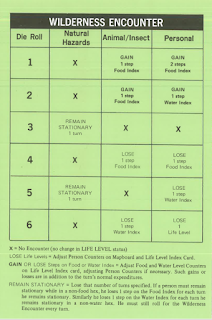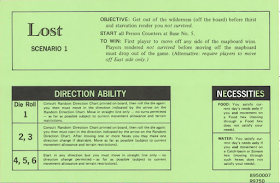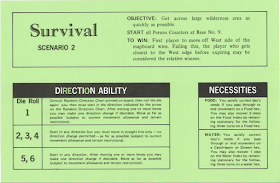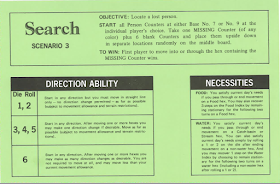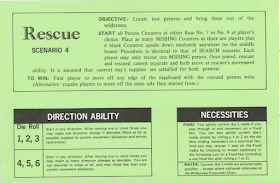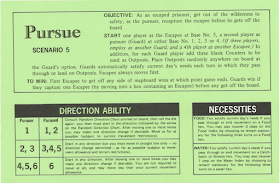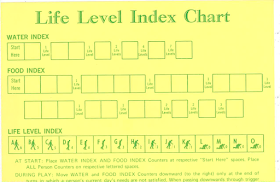How much territory to did old-school tournament players manage to cover, back in the day? This is an issue that I've discussed with some of my friends, and in general it seems a bit opaque to me. Following up from last week, I see the "Tournament" markings on classic Gygaxian adventures like the S-, G-, and D-series, and then beat myself up as DM because my players get to only a very small fraction of such an adventure in a 4-hour time slot (like at our annual mini-convention of HelgaCon). What am I doing wrong?
Here are a few scraps of evidence I've built up which point to an answer of "possibly nothing".
Slavers Series
Consider the Slavers A-series of modules, first used in 1980 at Gen Con XIII and published later that year and the next, by various authors (Cook, Johnson/Moldvay, Hammack, and Schick). One of the very nice things about the series of modules is that they make explicit what reduced part was used in actual tournament play (as well as other details, like how to score such a tournament). For each dungeon level, regardless of how expansive it is, the module highlights a sequence of around a dozen areas noted as in use for that stage of the tournament (ranging from around 9 to 15 areas by my count; generally the same number for both levels in a given module by a particular author).
But that doesn't help a whole lot for the Gygaxian modules, which do not have any hint of different configuration for tournaments in their text, and were used at tournaments in earlier years (1975-1978). This possibly leaves an open question if expectation were different at that time.
Battle for Snurre's Hall
Going back in time a bit, one of the most useful pieces of data comes from
Dragon Magazine #19, in October 1978, which published the story of the winning team from the Origins tournament that year. This was written by the leaders of that winning team, Bryan and Kathy Bullinger of Morgantown, WV (3 other players being friends they knew from Morgantown, with 3 others hailing from Michigan; a high level of cohesion and cooperation is noted throughout the article). This story runs about 2½ pages (see p. 3, 4, 6, and 20 to piece the whole thing together); plus there's an additional article by Bob Blake (p. 6) on how the G- and D-series tournaments were scored.
The writeups for G1 and G2 are relatively short (3 paragraphs and 1 paragraph respectively). By my count, in G1 this winning party got through about 12 encounter areas total (entering by #22 and then exploring much of areas #1-11 on the upper level), including one room of the dungeon level (trap #29), and a major planned assault on the feasting giants in the Great Hall. In G2 they seem to have cleared out at least areas #9-10 and #15-20 (which are on opposite sides of the rift); so that's a lower bound 8 areas, with at least 1-2 other areas necessary to pass from one of those locations to the other, and quite likely more than that. In an italicized sidebar, the DM who ran their session ("Your Kindly Editor", I think Tim Kask?) seems to tweak them for not having any knowledge of the lower level of the place, and uses the opportunity to pump orders for the G2 module then on sale for a low price of $4.49.
The memoir for G3 is much more extensive and detailed: 22 paragraphs, with 5 of them italicized inserts by the DM who ran their session (with behind-the-scenes information). Here on the first level they seem to have snuck past area #1, explored #12-14, instigated a major fight at #24, and with giant reinforcements converging from all over, attacked area #2-3 and successfully killed the King and Queen immediately before time was called on the session (thereafter prompting an argument about whether they could have feasibly escaped or not).
In summary: In G1 and G2 this team cleared out about a dozen areas each, while in G3 only about a half-dozen rooms (again: this being the
winning team of the Origins '78 tournament). G3 in particular is truly a brutal module; it makes me feel not so bad about the TPK that occurred last time I ran it. If the versions of G1-3 published by TSR were in use at the tournament, this best-of-class team mostly just explored a portion of the first level in each case.
(Coincidentally, I should be running G3 again the weekend that this post goes up, at a red-hot July-4th weekend party. As I write this I'm wondering: How that will have gone this time?)
Tomb of Horrors '75
Here's another early report that I just found in Jon Peterson's
Playing at the World (p. 527-529). Jon recounts Mark Swanson's story of playing in the D&D tournament at Origins I in 1975, in the first appearance of the S1 module (this being published in
Alarums & Excursions #4). Apparently the game was played in groups of 15 players at a time, in 4 time slots across that weekend; two groups played at once, the first refereed by Gary Gygax, the second by his son Ernie Gygax. Parenthetically, Jon reports that the winning team was selected by Gygax in terms of the most treasure looted from the dungeon.
Swanson had apparently played D&D before, but many of his fellow players had not, so he took the role of caller. From the description, it appears that Swanson's group explored areas #1, 3, 5, 7, 8 (presumably traveling through #9 and 10), to area 14B before time was called on the session. Swanson is among the many harsh critics of the S1 module, finding the experience, and by inference Gygaxian D&D in general, to be downright unpleasant. One grievance in particular is that his habit of deploying guards against wandering monsters slowed his group down in this scenario.
So it seems that Swanson's group may have only explored about 8 locations on the S1 map. On the other hand, he does point out that another group did finish the whole module in the same time, "possibly aided by rumors", which is about 18 areas by the most direct route possible. In terms of "rumors", Swanson might mean scuttlebutt at the convention (it was a "later party" who won), or possibly discovery of the riddle-clue at the start of the dungeon (which I have pointed out many times, to anyone I can,
radically changes the texture of play in S1). I think that somewhere in a
Dragon magazine there's another short anecdote from that winning party, that they used one of the dungeon's deadly traps against the arch-villain to win the day.
In summary: Again it seems that tournament parties are exploring between about a half-dozen and a full dozen encounter areas, or thereabouts.
Lost Tsojconth '76
Acaeum.com reveal another piece of information: The exact tournament format of several early modules, including:
S4 (Gygax, Wintercon 1976),
C1 (Johnson & Leason, Origins 1979), and
C2 (Hammack, Wintercon 1979). In each case, the module came in a Ziploc bag, with a cover and photocopied loose-leaf sheets. The proto-S4 is noted as being 8 pages long (compare to the mass published format: the text of the dungeon alone being 16 pages; including wilderness components, art, maps and pregenerated characters the booklet is 32 pages long; not counting the supplemental 32 page booklet of new monsters and magic items). C1 and C2 are noted as having printed 25 copies for staff, 50 for tournament DMs, and 300 numbered copies for sale at the indicated convention; Acaeum assumes that the early S4 was printed in about the same numbers. So: Even though the mass-printed version of S4 in 1982 gives little hint of it, the tournament dungeon must have been of lesser extent and/or detail, likely only about half of the later official printing.
Edit: An inspection of the original '76 tournament materials reveals some more detail. Originally it featured only the tournament dungeon component (no wilderness setting). While the maps are roughly similar to those in S4, the encounter descriptions are far more cursory: generally just a few lines each, describing each monster and treasure. This results in the entire description for each level fitting on a single page each (plus another page describing the ultimate encounter with the arch-villain, and full details on the artifact found there). For a complete side-by-side comparison, check out
grodog's page.
In conclusion, I think I can forgive myself for not exploring the entirety of any of Gygax's "tournament" modules in a standard 4-hour convention game. It seems like most playing groups at the time may have only explored a half- to one-dozen areas at most.



